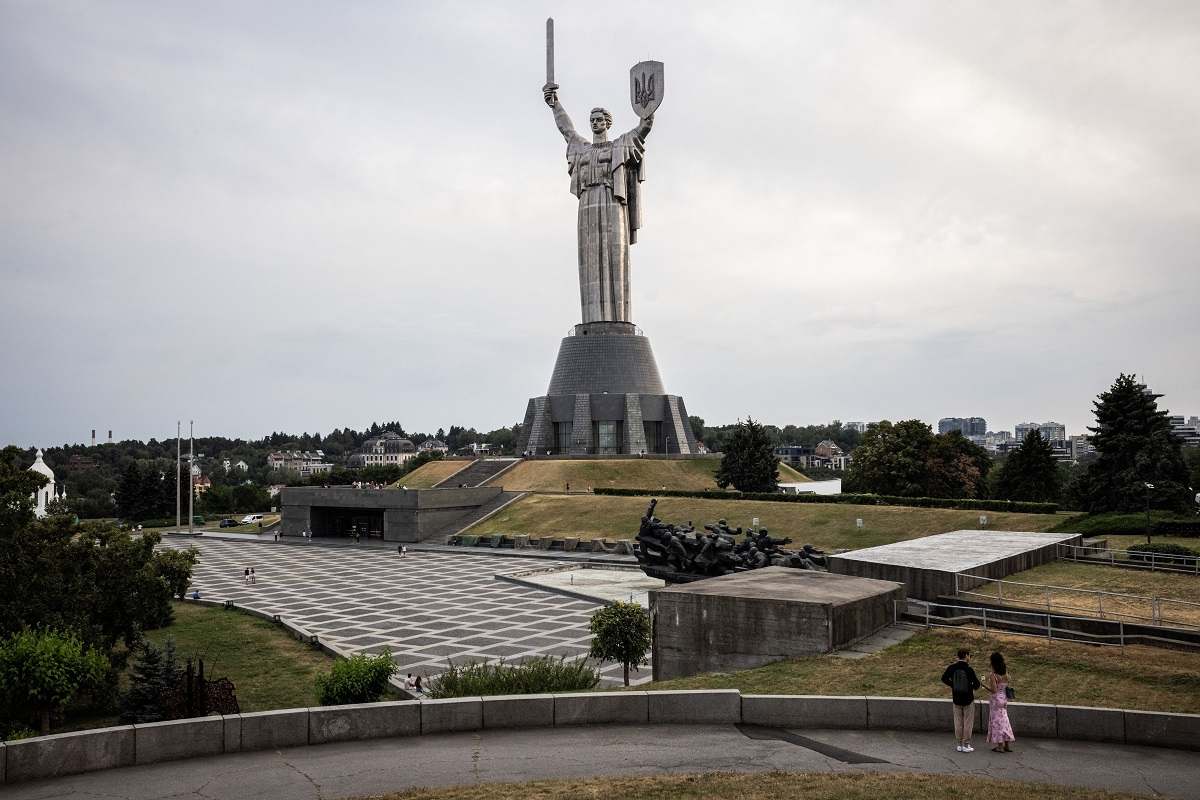
A monument, the Motherland, stands above Ukraine’s war museum in Kyiv on Sept. 1.
16:09 JST, September 8, 2024
KYIV – What’s left of a concrete copy of Vladimir Lenin’s nose – which, until recently, was part of a statue of the Soviet leader in Sudzha, Russia – is now on display in the capital of Ukraine.
The broken nose, collected by the director of Ukraine’s war museum on a cross-border trip after Ukrainian troops seized Sudzha last month, was unveiled Friday in a new exhibit in Kyiv that documents Ukraine’s surprise Aug. 6 military incursion into Russia’s western Kursk region.
“There is a phrase among film and television artists that ‘the picture can disappear,’” museum director Yuriy Savchuk, 59, said in an interview as museum staff rushed about preparing the space for the new exhibit. “We may lose this first picture of the war. And so, we needed to see it, to feel these emotions, to witness it with our own eyes in order to reproduce it in the public space.”
“Thanks to our defense forces,” he added, “we managed to make this short, urgent tour.”
Savchuk crossed into Ukrainian-controlled Russia four times last month, returning with a diverse haul of items: local newspapers, movie posters, a handwritten sign from a civilian bomb shelter, a hammer-and-sickle flag from a fire station and, perhaps most symbolically, a blue, bullet-ridden sign showing where the roads to Ukraine and Russia diverge.
The museum’s display of some of those items, along with archival Ukrainian maps of Russia’s border regions and recent photos from Kursk, chronicles how Kyiv turned the tables on Moscow last month, seizing some 500 square miles of Russian territory and hundreds of Russian prisoners of war. The exhibit and the haste with which it was opened reflect how Kyiv sees its seizure of Russian territory in the first such assault on Russian soil since World War II.
The fork in the road sign, Savchuk said, “very symbolically and figuratively demonstrates not just that we have gone in different directions … [but] how far we have already moved away.”
Some of the territory seized inside Russia was long ago considered part of Ukraine, and Savchuk said he hopes the archival display, which describes the region’s history, drives home that “even if territorial claims existed in the past, it does not justify resorting to war in the present day.”
Ukraine has insisted that it brought the war to Kursk to create a buffer zone, push Russian forces from the border and demoralize Russian troops – and has not claimed it plans to try to permanently expand Ukraine’s own modern borders, set in 1991, which Russia has tried to redraw.
When asked how he would respond to any criticism that he had looted the items he brought over the border, Savchuk said he would profoundly disagree. “This is property that has been smashed, destroyed,” he said. The Lenin monument, for example, was damaged in a suspected Russian drone attack, he said – not intentionally destroyed as an act of revenge.
“I absolutely believe that we cannot even use the term ‘artifacts’ or ‘cultural property’ to refer to these objects when they are in Russia,” he said. They only become “mementos and testimonies of this war in our collection, in our museum, where we will keep them for life.”
Russia, he added, is meanwhile “deliberately destroying cultural objects” in Ukraine.
For its part, Russia exhibits items taken from Ukraine during the war, including in a display this summer at Moscow’s State Historical Museum, just off Red Square. Visitors were shown bullet-riddled street signs from the now-occupied eastern Ukrainian city of Bakhmut, Azov Brigade T-shirts and paraphernalia – and a cello that curators claimed had been taken from the destroyed Mariupol Drama Theatre. One wall of the exhibition described Russia’s justifications for its full-scale invasion of Ukraine, describing how the war was “forced upon” Russia.
Yuriy Horpynych, an exhibition manager at Kyiv’s state-funded war museum, said his boss did not tell the staff that he was embarking on a trip to Sudzha until after he had gone. The collected items are “not for our own use. It’s a museum collection … It’s not like an exhibition of trophies,” he said. “We don’t take it from people who need it.”
In Ukraine, he added, “Russians looted everything they can find.”
Pat Griffiths, International Committee of the Red Cross spokesperson in Ukraine, said that he could not speak to the legality of any specific case because his organization maintains neutrality. “What I can say is that in any armed conflict, anywhere, at any time, private, public and cultural property is protected,” he said, referring to the Geneva Conventions and other laws of war.
Savchuk took his job at Ukraine’s World War II museum in late 2021. Within months, his role changed as he shifted his focus from historical research on a century-old war to documenting the new war as it took place in his own home.
In April 2022, days after Russian troops retreated from the Kyiv region, Savchuk requested permission from the Ukrainian military to travel through just-liberated territories to collect evidence to display in the museum.
Much like in Sudzha, his task was urgent. To make his collection historically accurate, he had to arrive first, before others had sifted through the destruction. Over 12 days that month, he collected abandoned Russian soldiers’ boots, ID cards and rations, now on display in the museum previously dedicated to the Soviet-Afghan War.
His team then installed a recreation of a civilian bomb shelter they visited in the Kyiv suburb of Hostomel. In the museum basement, visitors feel their way through an immersive exhibit and experience the dark, cramped, degrading experience of wartime life. Across Ukraine, some civilians still live full-time in similar shelters. Many others take still cover in them during regular Russian airstrikes.
When Ukraine liberated other territory later in 2022, Savchuk again rushed to visit the areas – still mined and vulnerable to Russian assault – to add to his collection.
But the visit to Sudzha was more complicated, he said. The week he visited, the city remained extremely dangerous, with regular Russian drone, missile and glide bomb attacks. Some Russian soldiers were still hiding in the surrounding forests or inside civilian homes.
For his first trip, he crossed with the Ukrainian military, wearing a flak jacket and helmet, he recounted. But the next three days, he and a young photographer working for the museum traveled around Sudzha in their civilian van with Kyiv plates.
When crossing through a checkpoint in the last Ukrainian village near the border, troops raised their eyebrows when he said he worked for a museum. But then one soldier recognized the car. By chance, he was the same soldier who had accompanied Savchuk’s team on their first excursions outside of Kyiv in 2022.
Once inside the Kursk region, they rushed through the town searching for items that would help explain the significance of the incursion. At one point, they watched Ukrainian soldiers shoot a flagpole to help take down a Russian flag.
“You don’t know if you’ll be back on this street later. You don’t know your route. You don’t know how long you will be there,” he said. “And it is extremely difficult. You need to instantly navigate, instantly think about what things you need.”
Racing from street to street, Savchuk said he and the photographer were so excited imagining the future exhibit that they were “high on adrenaline and happiness hormones.” Savchuk even tried to take a cat he found at the border crossing, he said, promising her that she could live in his museum – but she jumped out of his car window and ran back to Russia.
In the civilian shelter in the basement of a former school in central Sudzha, he saw elderly people huddled on mattresses in a basement, using a bucket for a bathroom. The basement, he said, looked exactly like the one from Hostomel that he recreated in Kyiv.
“It’s absolutely the same,” he said. “It’s amazing.” He asked the civilians if he could take the handwritten poster written outside that warned that only civilians – not soldiers – were inside. It looked identical, he said, to signs Ukrainians had installed outside their own homes or shelters.
“It is a great tragedy, a great disaster, a great misfortune for civilians,” he said. “And everyone finds themselves in similar situations.”
Once they had what they needed – and after narrowly avoiding a Russian drone attack – they decided to leave. The museum was waiting for its new collection. And if they were going to install it in time for the one-month anniversary of the incursion, he said, “we had to save our lives.”
"News Services" POPULAR ARTICLE
-

American Playwright Jeremy O. Harris Arrested in Japan on Alleged Drug Smuggling
-

Japan’s Nikkei Stock Average as JGB Yields, Yen Rise on Rate-Hike Bets
-

Japan’s Nikkei Stock Average Licks Wounds after Selloff Sparked by BOJ Hike Bets (UPDATE 1)
-

Japanese Bond Yields Zoom, Stocks Slide as Rate Hike Looms
-

Japan’s Nikkei Stock Average Buoyed by Stable Yen; SoftBank’s Slide Caps Gains (UPDATE 1)
JN ACCESS RANKING
-

Keidanren Chairman Yoshinobu Tsutsui Visits Kashiwazaki-Kariwa Nuclear Power Plant; Inspects New Emergency Safety System
-

Imports of Rare Earths from China Facing Delays, May Be Caused by Deterioration of Japan-China Relations
-

University of Tokyo Professor Discusses Japanese Economic Security in Interview Ahead of Forum
-

Japan Pulls out of Vietnam Nuclear Project, Complicating Hanoi’s Power Plans
-

Govt Aims to Expand NISA Program Lineup, Abolish Age Restriction



















